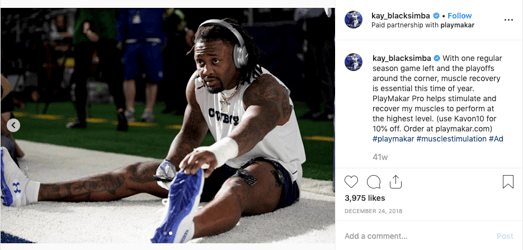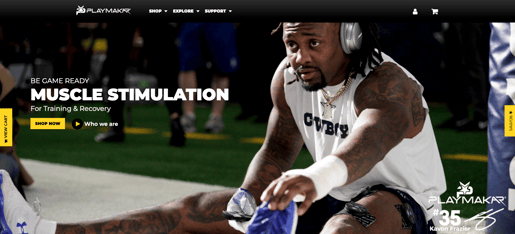Influencer marketing is an affordable, effective way to build trust, increase brand awareness, and drive purchasing decisions.
At OpenSponsorship, through our innovative technology and extensive network of 15,500+ athletes, you can launch a successful influencer marketing campaign in 3 weeks or less.
Here's how to get started:
Step 1: Actually choose your influencers.
It sounds simple, yet for some reason it isn’t. Many other influencer marketing companies exist where you pay money, hand over some copy, and let your previous product go wherever the wind takes it.
Unfortunately, this doesn’t typically yield valuable outcomes. Just like a business, every influencer has their own audience. Influencers attract an audience due to some overlapping interests with their audience - whether those interests are fitness, diet, beauty, etc.
To run an influencer marketing campaign, you want to be able to vet a number of influencers to understand which one’s audience matches up with your target demographic to yield the best results. You also want to be able to work directly with the influencers, rather than letting a third-party handle that communication.
Rather than spending hours searching through the internet for athletes with strong follower numbers and engaging content, use our platform of 5,500+ athletes to search and filter for athletes that perfectly align with your target demographic in just a few minutes.
Choose your influencers with OpenSponsorship.With over 5,500+ athletes in our database, we bring influencers to you. All it takes is posting a campaign to our portal, and athletes will find and apply for the campaigns that suit them, giving you the ability to quickly and easily vet who is right for your brand. |
Step 2: Set clear, achievable goals before each influencer marketing campaign.
You’d be surprised at how many brands are willing to just give companies their money without setting any achievable goals. (Or maybe, savvy marketer, you aren’t that surprised. Let’s all take a collective calming breath to try and forget the last time your boss demanded sales numbers from a campaign you told them was about awareness. Okay. Let’s continue.)
We realize that many companies don’t have budget that can be wasted, so before you launch a campaign, set some key goals with your team. This way, there are really trackable data points that your team can look back on to ensure that both you and your influencers are aligned on what’s considered a successful campaign.
Generally, these goals fall into one of the following buckets:
- Brand Awareness: This goal is typically around how many impressions you can drive to increase awareness of your brand.
- Traffic: This goal is tied to an influencer driving a certain volume of traffic back to a particular site or landing page.
- Sales: Whether in leads or actual purchases, if you choose this goal you want to ensure your campaign is tied to some sort of cost-per-click.
- Audience Growth: This is typically tied to a campaign where you’re looking to increase your social media following by having influencers recommend they follow your account.
By leveraging our campaign templates for social media posts, long-term partnerships, and more, you can create an influencer marketing campaign in minutes.
Step 3: Create an influencer campaign that’s mutually beneficial.
This may sound obvious, but oftentimes brands look at influencers for their audience without regard for what would benefit that influencer. Think about it this way: When hiring a sales rep, you want to ensure that rep is excited about your product because at the end of the day, they are the ones selling it. By hiring an influencer, you’re hiring someone to sell your brand, so you want them to be just as excited by the opportunity as you.
For some influencers, just receiving free product is enough, while others may want a cash guarantee for their work. The better your offer is tailored towards each influencer, the better their content is going to be on your behalf. It’s worth it to put in the time to ensure that each influencer deal is going to be a positive experience for both parties.
Influencer Strategy ExamplePlaymakar, a company based in Dallas, took photos that Cowboys player Kavon Frazier used on his Instagram, and repurposed them to use as content for their website.
|
Normally, negotiating terms and discussing a sponsorship opportunity with an athlete or their agent can take weeks. However, with OpenSponsorship, within 24 hours, athletes start applying directly to your campaign with pre-determined terms so you know who is interested based on the applications that come in.
Step 4: Track and measure your campaign.
The classic final step: Measuring your campaign. If you set a specific goal during step two, then you’re already in good shape. Now it’s just about ensuring you have the right tools to track and measure your influencer marketing campaign.
Here’s a few ways to make it happen:
1. Track with your own attribution.
The simplest and most overlooked step in tracking an influencer strategy is including tracking tokens in the links you have influencers share. Taking this additional step allows you to clearly see what traffic and conversions are actually being sent back your way from the influencers’ campaign. Here’s a guide to doing this correctly.
2. Track with OpenSponsorship.
Our platform not only helps brands connect with athletes for their influencer marketing campaigns, but we also provide tracking to help you see which campaigns are creating the best value for you. This also helps you evaluate which athletes to work with over time to be able to look back and see which ones led to the greatest ROI for your goals.
3. Track with a third-party tool.
While the above two should be enough, some companies opt to enlist tools specifically for tracking and measuring influencer marketing campaigns. This post goes into six different influencer marketing tracking tools you can try.
Follow these four steps, and we guarantee you’ll begin to see the light when it comes to an influencer marketing strategy within a few weeks. Just like any other marketing tactic that seems overhyped, it’s about executing correctly and matching your effort with what’s best for your brand.




